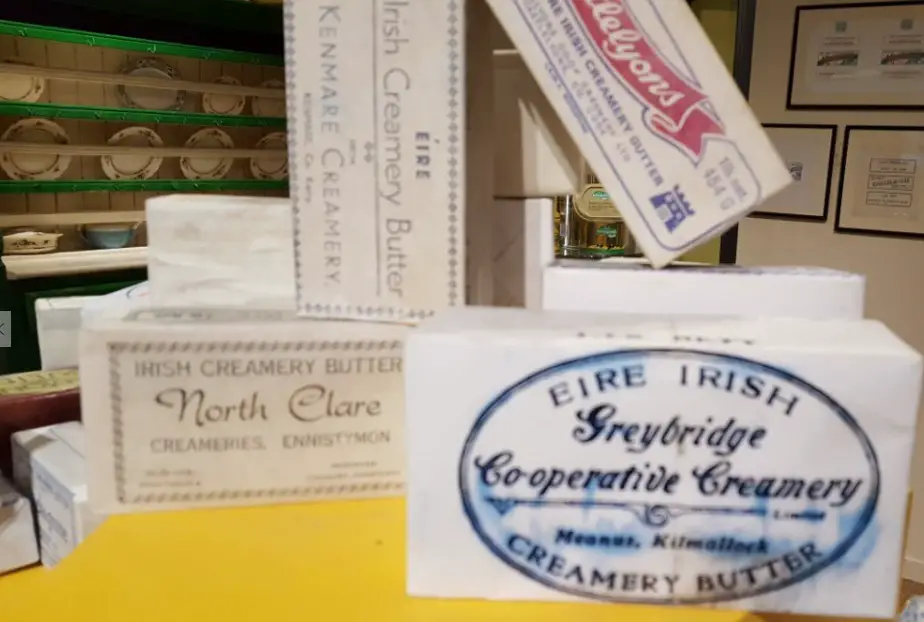Butter is included in the diets of many people from across the world. From smothering it on toast in the morning to using it for baking cakes it’s long been a staple pantry item because of its versatility but Irish butter does seem to be better than most…
Even if we do say so ourselves.
Irish butter can be used in the same way but it’s set apart from other kinds of butter due to its higher fat content and bright yellow colour.
As we’ve mentioned before, the Emerald Isle is full of green pastures which are perfect for grazing cows to fill themselves up on luscious grass leading to the wonderful end product you end up using.
Let’s look at some key details and famous brands behind this Irish food export champion.
What is Irish Butter?
Irish Butter Brands
The most famous producer of Irish butter is Kerrygold and it’s likely that you’ll see this brand of Irish butter in most major supermarkets across the UK, USA and some other European nations, alongside here in Ireland of course.
Kerrygold was first founded in the early 1960’s after the establishment of the An Bord Bainne (Irish for The Irish Dairy Board), and Kerrygold was the eventual name chosen, beating over 60 other suggestions.
Other common brands, although generally less well-known further afield, include Golden Cow Butter, Dromona Butter, and Ballyrashane Butter.
The other brand of Irish butter that you may come across is Lakeland Dairies which is an Irish Dairy Co-operative. Lakeland Dairies have been in existence since the 1890’s and today produce a whole range of dairy-based products, including Irish butter.
Types of Irish Butter
The traditional type of Irish butter is salted and this is the most common form of Irish butter available today.
There is also an unsalted version available, which is not as common as the salted version, however, it is available in larger retailers. Unsalted butter will generally be used in a lot of baking recipes.
How to Store Irish butter
Irish butter can be either stored in the fridge or the kitchen at room temperature and there are positives and negatives to both options.
Starting with storing it in the fridge, if not wrapped well it can start to absorb the flavours of other products, so be sure to keep covered and away from fresh food if possible. The positive of keeping it in the fridge will be the fresh and cool taste you will get when you come to use it.
Storing at room temperature is fine but you must ensure to keep in an airtight container and make sure that the conditions are optimal so that it doesn’t melt too much. The positive element of keeping Irish butter at room temperature butter is it will spread very easily.
Irish butter can also be frozen, providing it is wrapped well, meaning that this will last for a lot longer and can be defrosted for a time of your choosing.
What does Irish Butter Taste like?
As mentioned earlier, Irish butter can come in two varieties; salted or unsalted. No matter which one you choose, you can expect a creamy, golden-tasting butter that will remind you of rolling green hills and very happy cows.
What Can you Do with Irish Butter?
The short answer is that you can do whatever you want with Irish butter, but if you’re after some inspiration, here are a few ideas.
- Smother freshly cooked corn on the cob in salted Irish butter to give a perfect accompaniment to a main dish. Even better if the corn is cooked on the BBQ!
- Add some Irish butter to freshly cooked vegetables to give them an Irish boost.
- Simply add it to a fresh piece of bread or cover a piece of toast with it.
Irish Butter Recipes
If you enjoy cooking or baking and you haven’t tried using Irish butter then this is something you should consider next time you put on your apron.
Here are a couple of simple recipes that Irish butter will help make better.
- Garlic butter: swap your regular butter for Irish butter and tell us it’s not much better. The combination of fresh garlic, combined with Irish butter and fresh parsley is a great combination. Perfect as an accompaniment for a steak, or if you make your own garlic bread.
- Cakes and biscuits: If you’re a baker and enjoy making cakes or biscuits, swapping out your regular butter for Irish butter will add a new dimension to those home bakes.
Make sure you pick some Irish butter up on your next visit to the shop!

